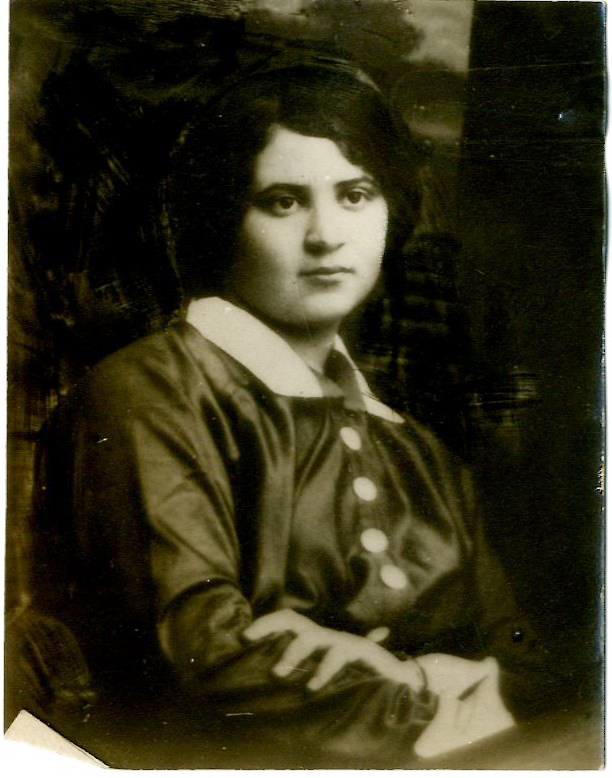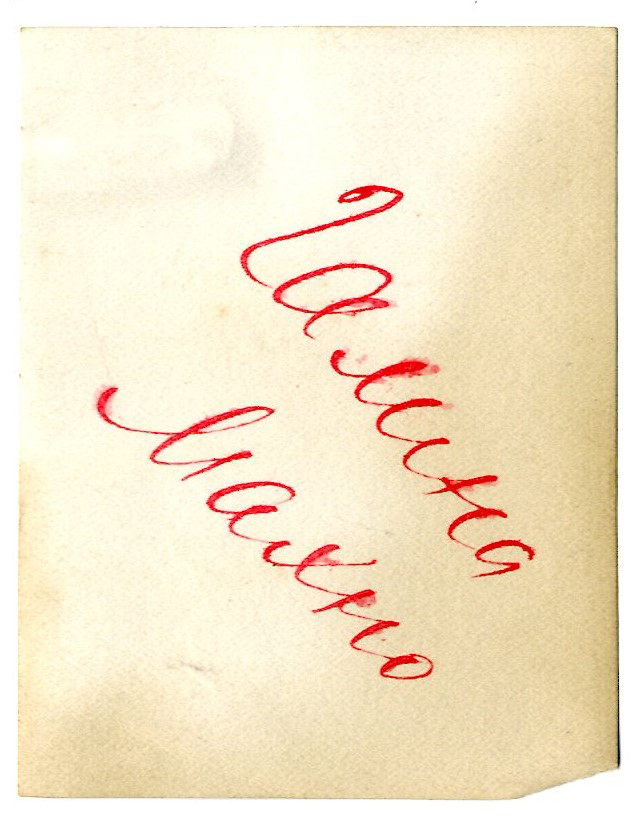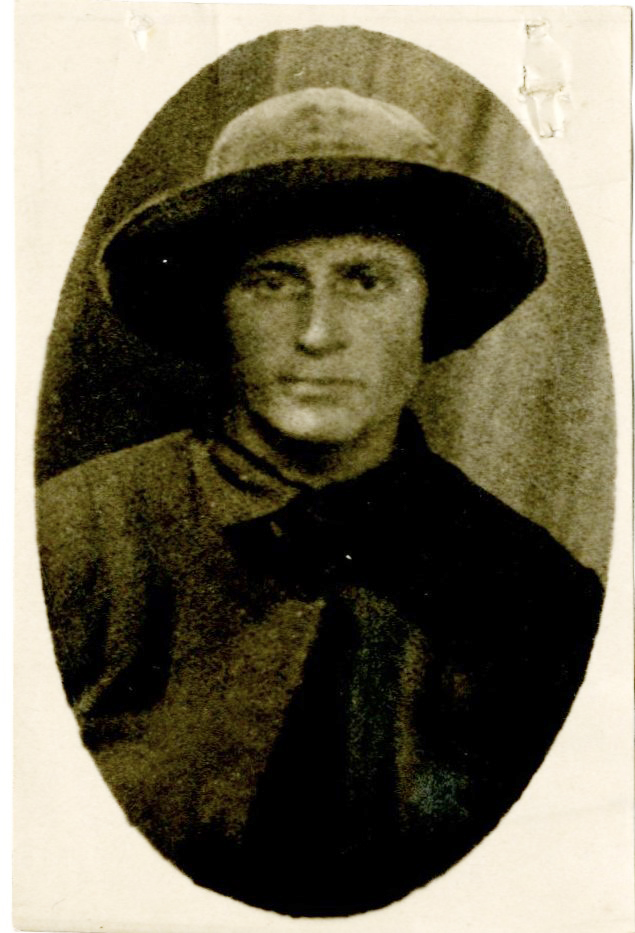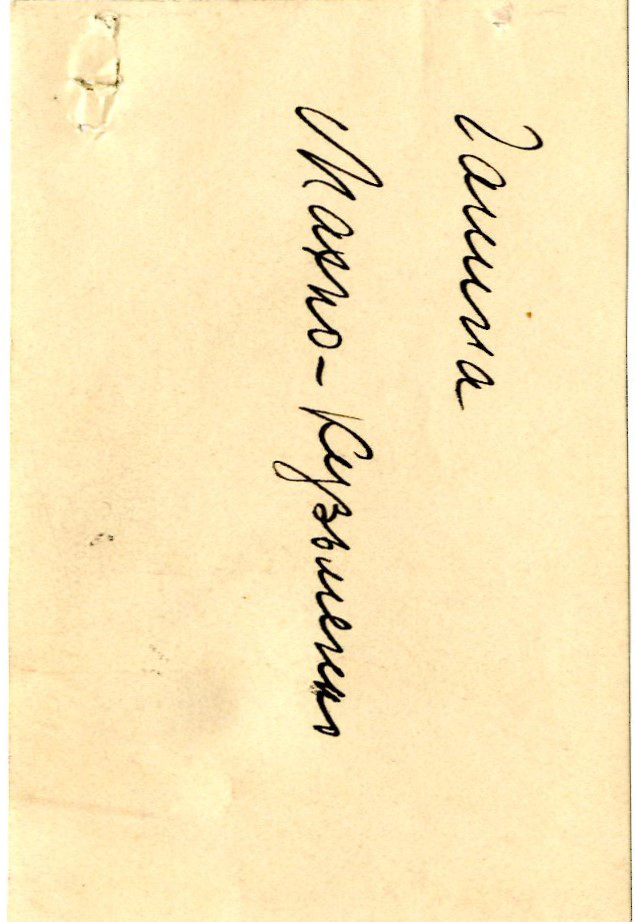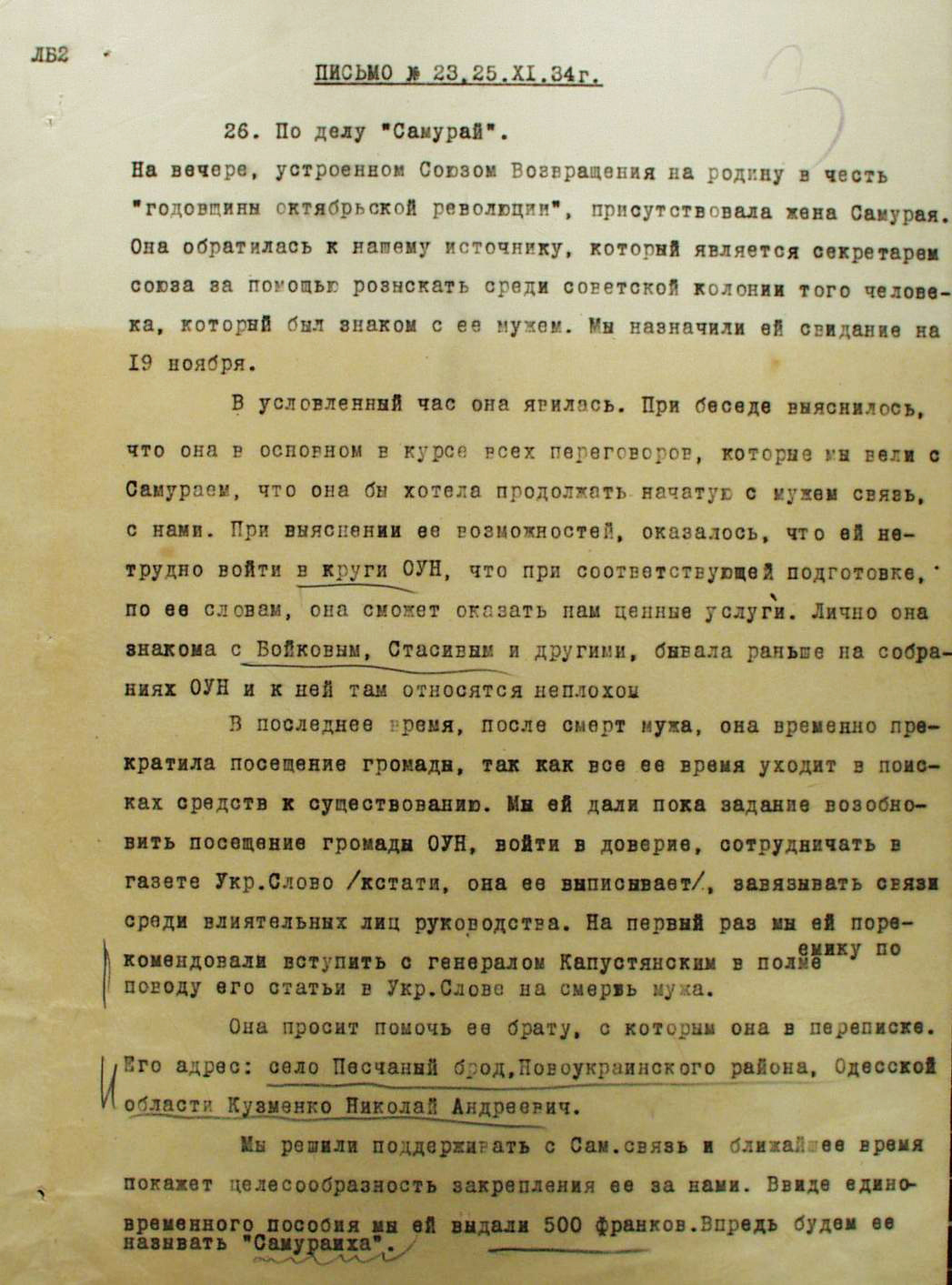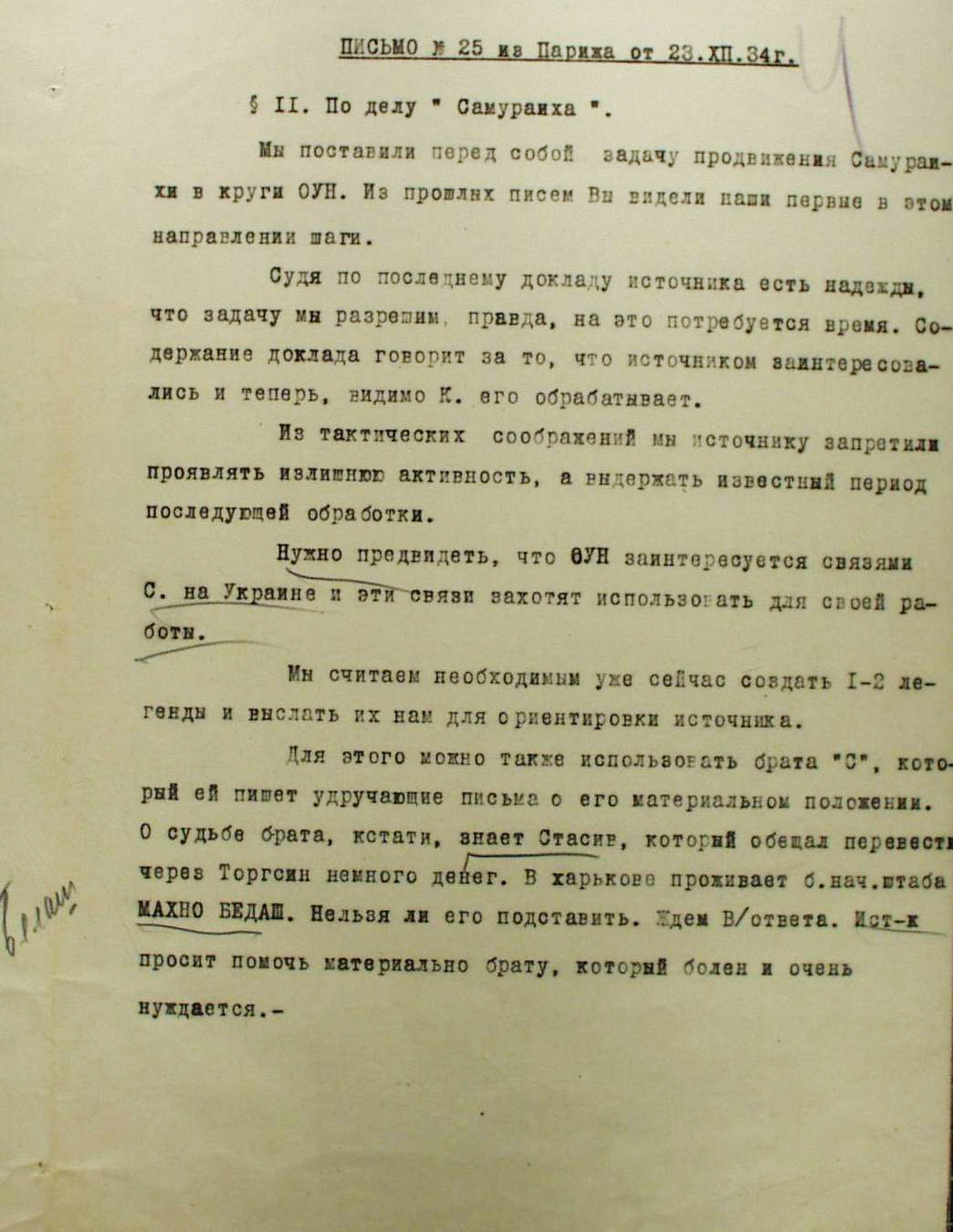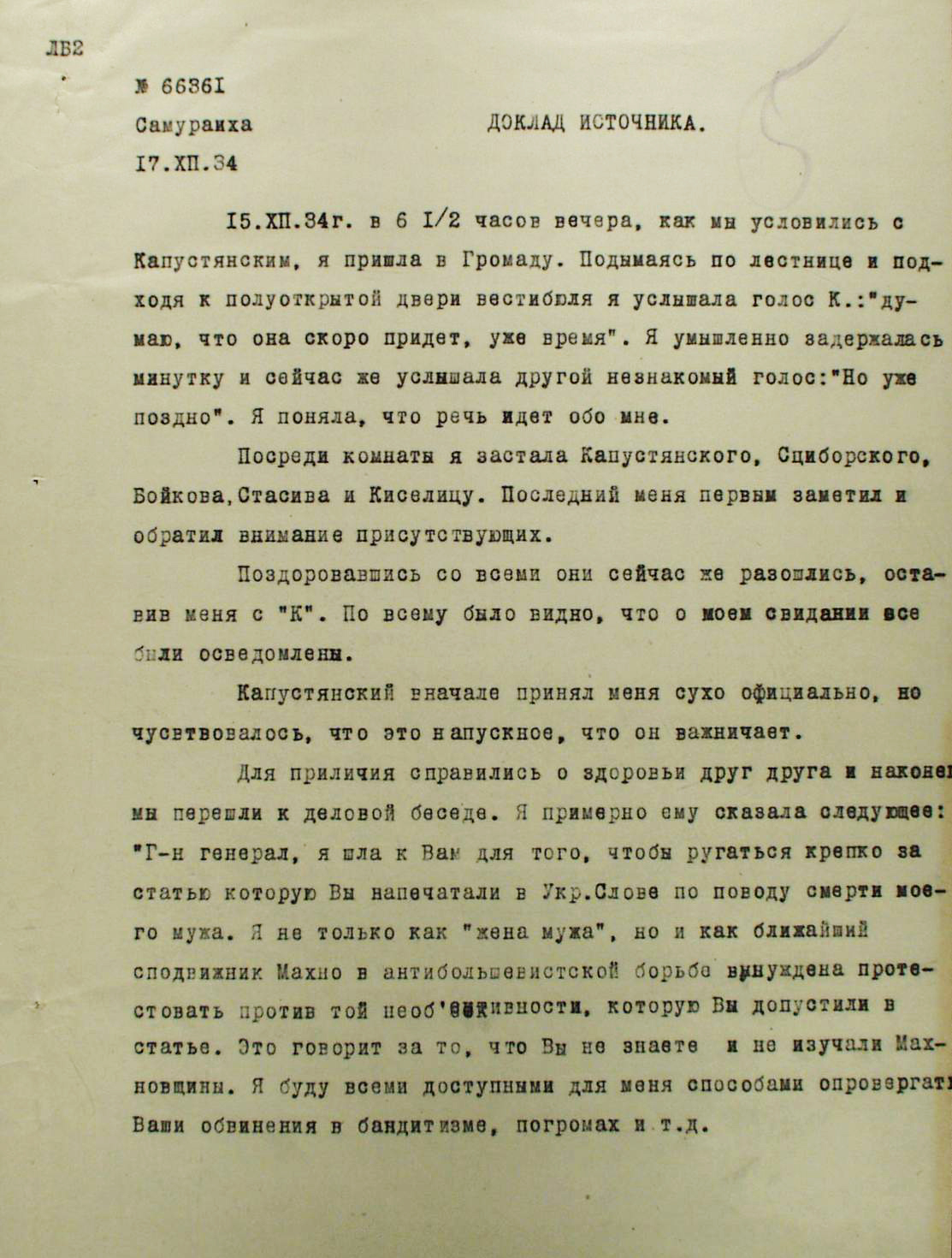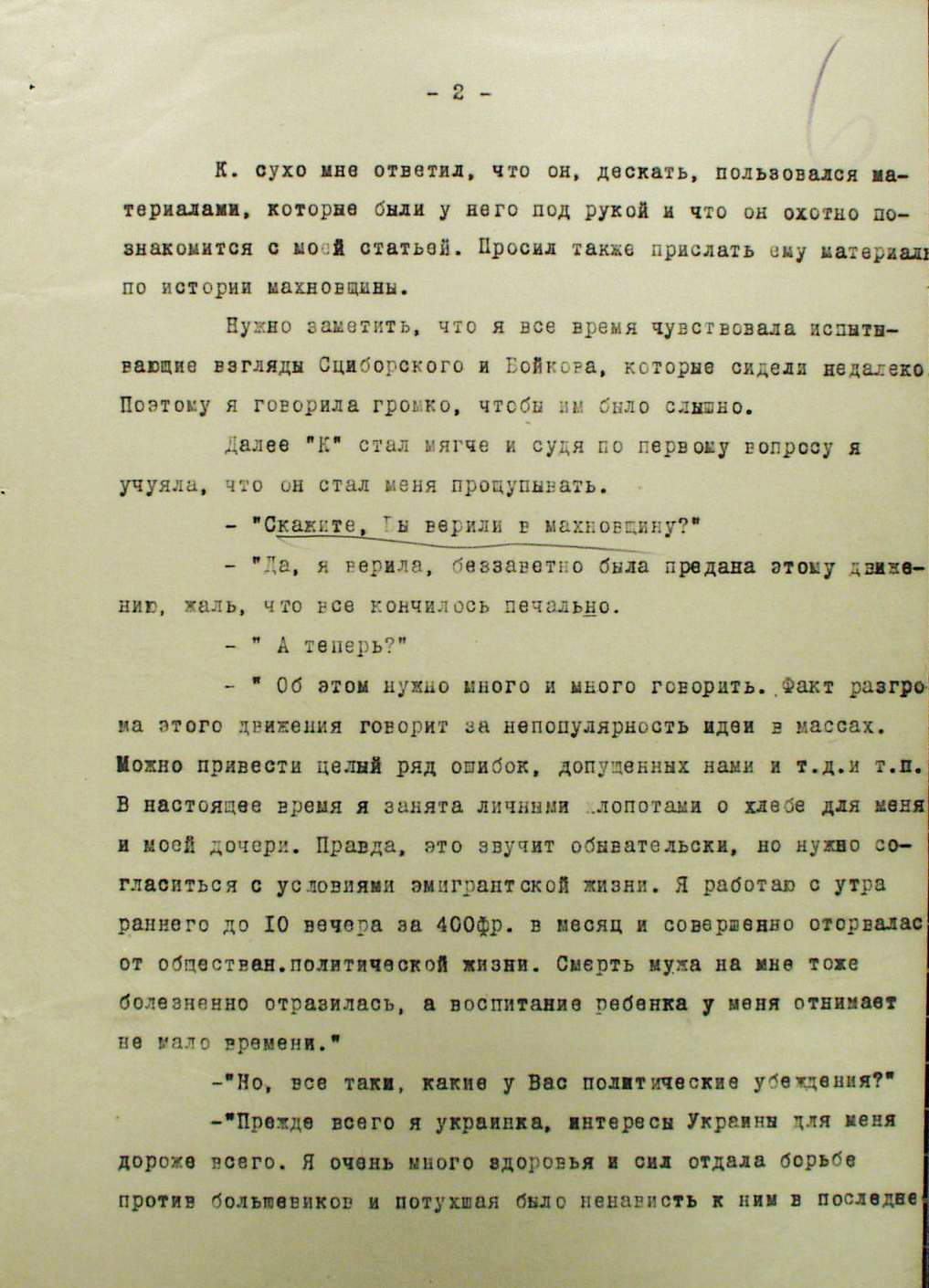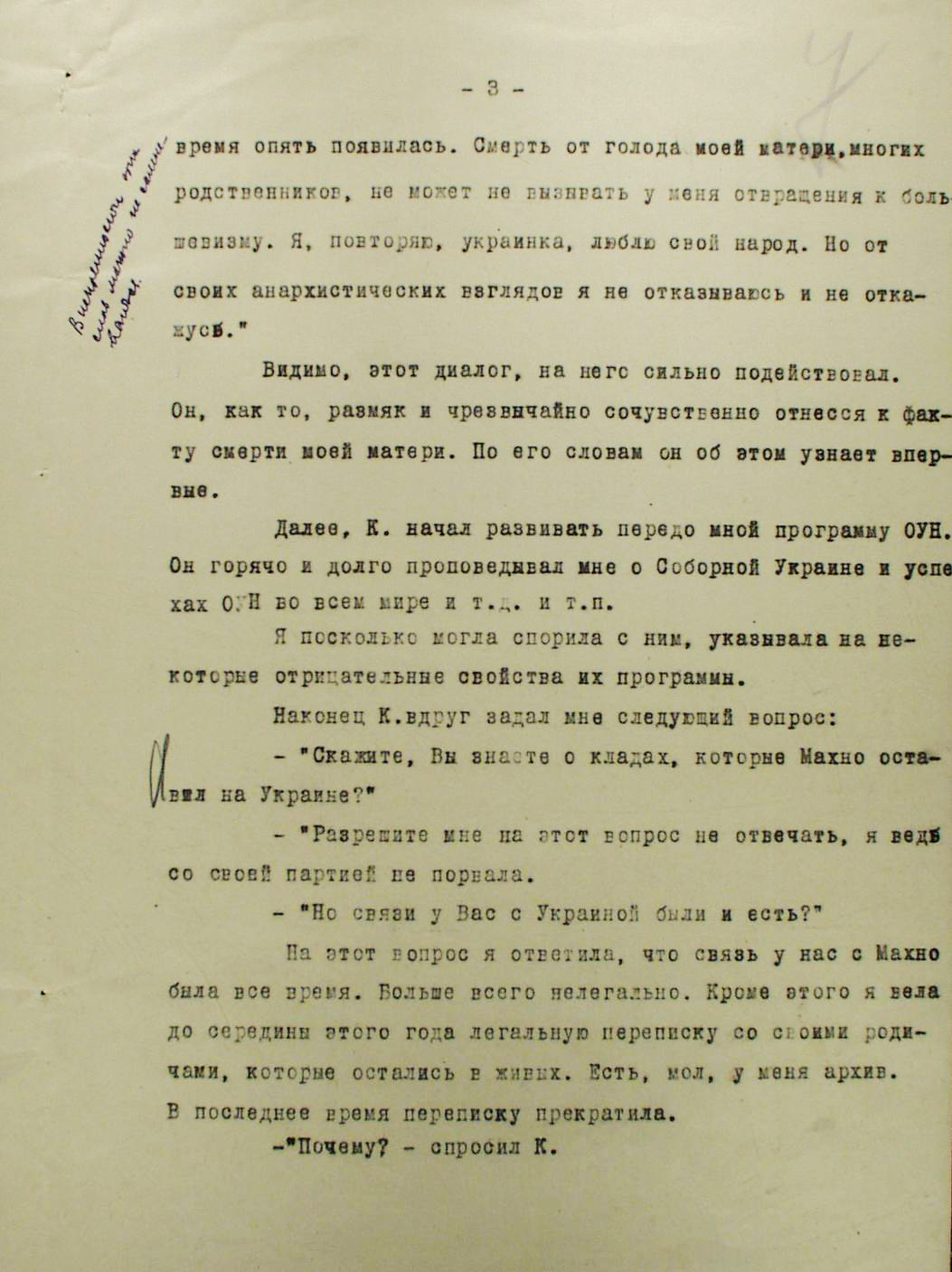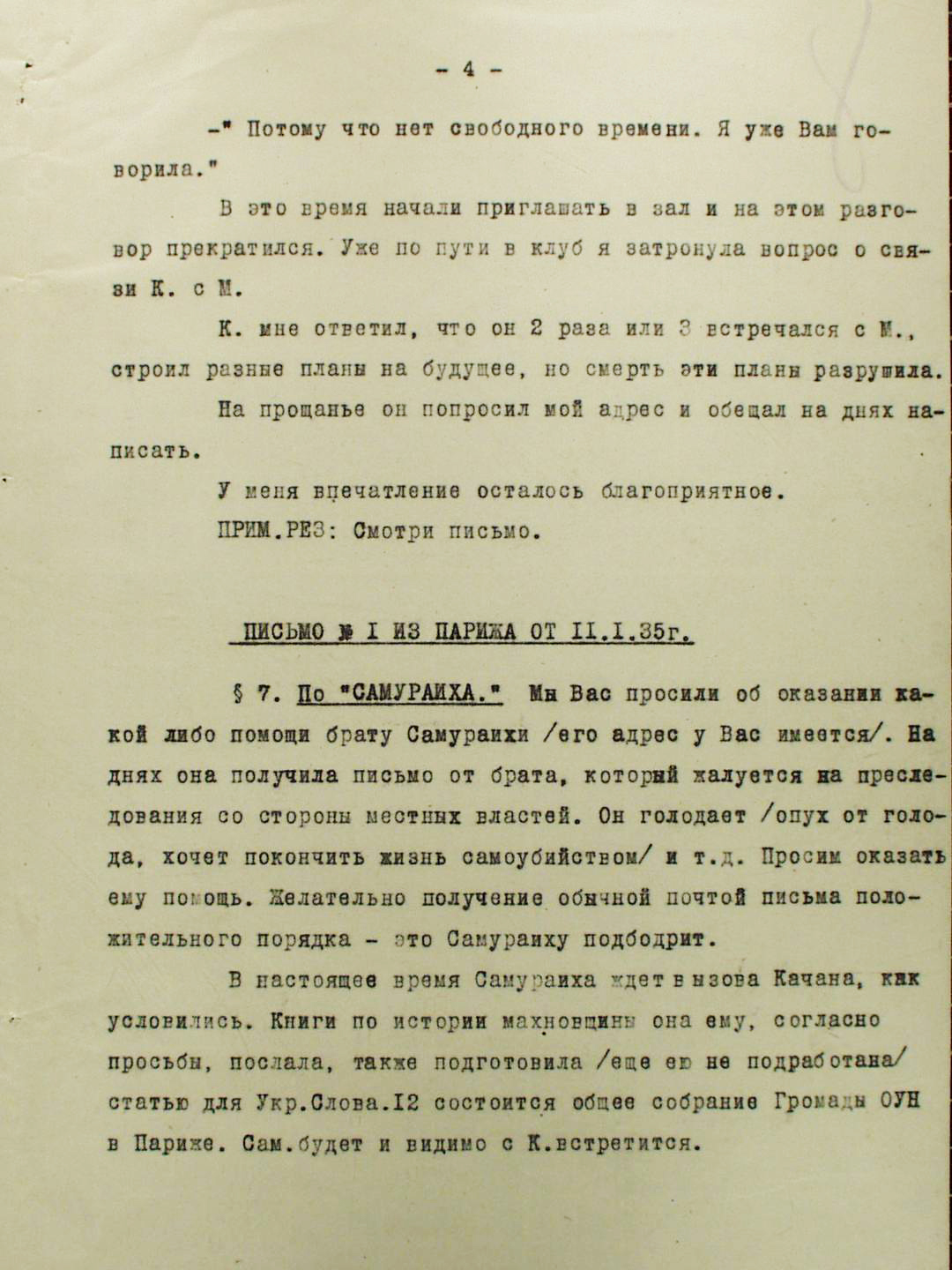Nestor and Halyna. In the gpu’s Close “Embrace”
10/26/2023
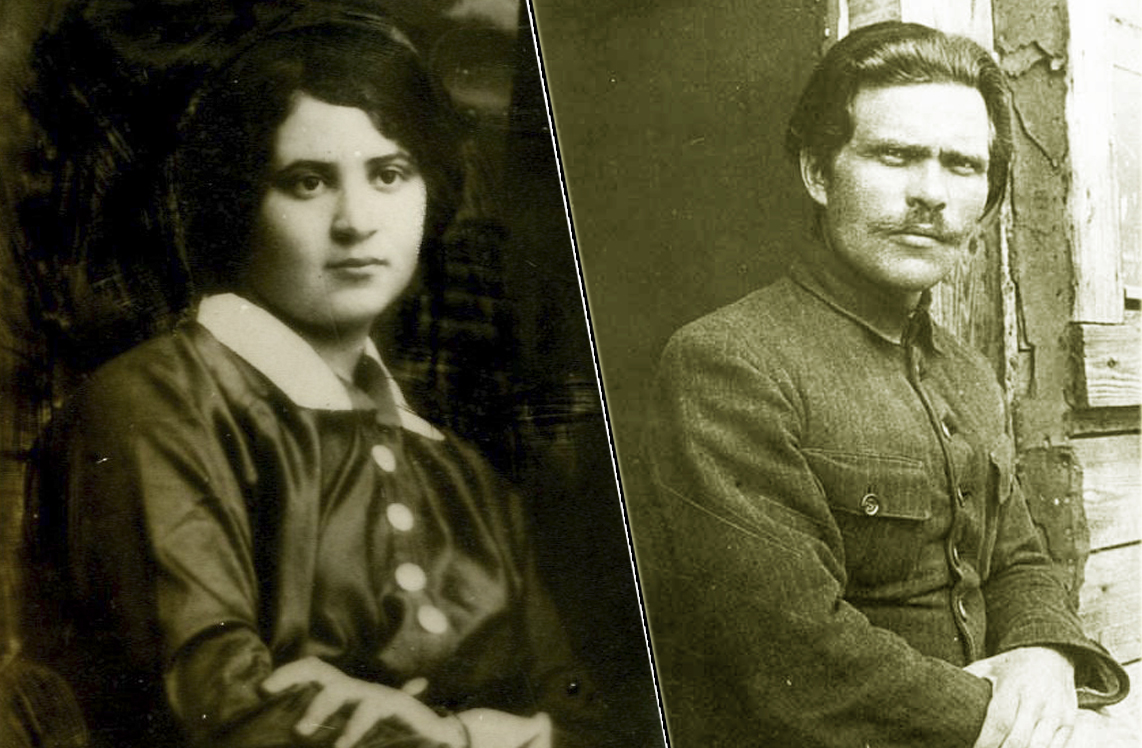
Among the various centers and political wings of the Ukrainian emigration, a separate direction in the gpu was set aside for work on the former Makhnovists. Special attention was focused on Nestor Makhno, for whose cultivation they tried to use people from his inner circle. In order to find out about the secret plans of the insurgent otaman, the chekists abroad even resorted to persuading his wife Halyna Kuzmenko to side with them. How this happened and how soon she was “thanked” for her cooperation we can learn from hitherto unknown declassified documents from the archives of the Foreign Intelligence Service of Ukraine.
“Samuraikha”
The first mentioning of Halyna Kuzmenko in the documents of the ogpu ussr dates 1922. That year, Makhno and a group of his supporters left Romania for Poland in search of a better life. Immediately after crossing the border, they all were detained by the Polish defensywa (counterintelligence) and placed in an internment camp in Strzałkowo. Nestor was under special supervision and had no right to go beyond the fence. Halyna, who was pregnant, could seek medical help outside the camp and move about more or less freely. Makhno then instructed her to submit the application to the embassy of the ukrainian ssr in Warsaw. It referred to the beginning of negotiations on the conclusion of an agreement with the soviet authorities on the possibility of returning to their homeland.
The consular department of the embassy immediately notified the people's commissariat for foreign affairs of the ukrainian ssr about the visit of Makhno's wife. In a letter dated July 29, 1922, it was noted that G. Kuzmenko “gave the impression of being overtired and discouraged, and asked for even a small financial help”. Then she was told that the government of the ukrainian ssr was unlikely to negotiate with regard to the entire group of Makhnovists. At the same time, she was told that everyone can individually ask for amnesty as one who actively fought against the soviet government. Such appeals were supposed to be considered and decisions to be made separately. Halyna was not satisfied with the answer, and she asked that her application be sent to the people's commissariat for foreign affairs of the ukrainian ssr.
Probably, the same events are referred to in the correspondence of the Warsaw residency with the gpu of the ukrainian ssr. In an operative report entitled “Makhno”, an employee of the residentura points out that he is sending two photos of H. Kuzmenko and adds: “The photo was taken during her latest stay in Warsaw. I attach it here. From this photo, you will see how much Halyna has changed. It is very difficult to deliver her to Kharkiv by diplomatic carriage. But in a conversation with the consul, it turned out that we can count on a possibility to do this” (BSA of the SZR of Ukraine. - F. 1. - Case 18. - Vol. 3. - P. 192).
That is, the gpu was then considering certain options regarding the secret transportation of Nestor Makhno's wife from Poland to the ussr in a diplomatic carriage and the possibility of using her in some operational cultivations. But there is no continuation of this story in archival documents.
Her another appeal to the consular department of the ussr embassy with a request to return to her homeland is dated 1928. That was already in France. At that time, Halyna and Nestor lived in the Paris suburb of Vincennes. She later told the following about the circumstances of the move. They together left Poland for Danzig. There Makhno was arrested, and she went to Berlin. In Berlin, an anarchist Volin helped her with the paperwork to move to France. In 1925, Makhno came to Paris from Danzing. From 1925 to 1927 they lived together. They divorced in 1927 and met only from time to time until his death in 1934. She explained the reason for the divorce by the fact that Nestor's tuberculosis had progressed – it had spread from the lungs to the bones, and she was afraid that her daughter would become infected from him.
In fact, the crisis in the relationship between Halyna and Nestor had been brewing for a long time, and the reasons for the divorce were much deeper. The details of this are not mentioned in archival documents. At the same time, the Paris residentura was aware of this and tried to use this circumstance for operational purposes. Halyna also wrote about the divorce to her relatives – her mother and brothers who lived in Ukraine. Those letters were regularly read in the gpu. From them they learned about her moods and views.
By that time, almost all close relatives and acquaintances of Makhno were already in the gpu’s operational cultivation. They had been thoroughly studied for possible use against him. Simultaneously, a separate case-form was opened, various operations and combinations were developed to find out about his plans, agents were introduced into his environment, – this was described in our previous articles on the basis of declassified documents from the archive of the Foreign Intelligence Service of Ukraine.
Then the gpu took up his wife's relatives and acquaintances. Secret operational contacts were established with some of them in order to collect as much information as possible. Among the archival documents there is a paper from the gpu of the ukrainian ssr, dated November 1932, about a conversation with Halyna's brother Mykola Kuzmenko. He told as follows: “Halyna divorced Makhno and is now in poverty. In the past, she often had misunderstandings with Makhno because of different political views, since she stood on the soviet platform. Halyna has great connections among the former Makhnovists and White émigrés who are in Paris”, (BSA of the SZR of Ukraine. - F. 1. - Case 7935. - P. 76).
At the end of the document, it is noted that the conversation with Mykola Kuzmenko suggests that Halyna could make contact with the gpu. And such contact soon took place.
There is no information about the details of Halyna Kuzmenko's involvement in cooperation with the Paris residentura of the ogpu of the ussr in the available archival documents: neither a report on recruitment, nor a non-disclosure agreement on the fact of such cooperation, nor how she perceived such an offer. It is only noted that she received the code name “Samuraikha”(“Samurai’s wife”- Transl.) by analogy with the fact that in operational cultivation Nestor Makhno was called “Samurai”.
Halyna might not have known that she was given the code name “Samuraikha”. At that time, she was working for the Union of ukrainian citizens in France (SUGUF). It was a sovietophile organization centered in Paris. It united Ukrainians who recognized themselves as citizens of the sovereign ukrainian soviet socialist republic. SUGUF was in opposition to other Ukrainian émigré nationalist organizations, in particular to the State Center of the Ukrainian People's Republic in exile. Therefore, the employees of the Paris residentura of the ogpu, when establishing contact with Halyna, could act on behalf of this organization or the “Society of friends of the soviet union”, or the soviet embassy, which was often practiced, and promise assistance in returning to her homeland in exchange for fulfilling certain requests.
Scattered references to the performance of such individual tasks by her date back to 1934-1935, after Makhno's death. He died in July 1934. That is, according to archival documents, she was not used in measures directly against him. Among the materials discovered, there is no evidence of her in any way compromising Makhno or portraying him in a negative light. On the contrary, she defended him and tried to do so in the public space.
In particular, this happened after Mykola Kapustyanskyi, who at that time was the leader of the Ukrainian community in France and an active member of the OUN, published an article in the newspaper about Makhno's death. In it, he criticized him for his activities during the Ukrainian Revolution of 1917-1921. To this, during one of the conversations with M. Kapustyanskyi, Halyna said the following: “Mr. General, I came to you in order to quarrel strongly over the article that you published in the “Ukrainian Word” about the death of my husband. Not only as his wife, but also as Makhno's closest comrade-in-arms in the anti-bolshevik struggle, I am compelled to protest against the bias that you have allowed in the article. This shows that you do not know and have not studied the Makhnovshchyna. I will refute your accusations of banditry, pogroms, etc., by all means available to me” (BSA of the SZR of Ukraine. – F. 1. – Case 7932. – P. 5).
This conversation with M. Kapustyanskyi was not accidental. The gpu decided to purposefully use H. Kuzmenko in its work against the OUN.
In the Circle of Prominent Figures of the OUN
“We have set ourselves the task to infiltrate Samuraikha into the circles of the OUN”, reads one of the letters from the Paris residentura, “… It follows from the latest report of the source that we will accomplish this task. However, this will take time. The content of the report indicates that (the gpu) is interested and now K. is apparently cultivating her. It is necessary to foresee that the OUN will be interested in S.' ties in Ukraine, and will want to use these ties for its work” (BSA of the SZR of Ukraine. – F. 1. – Case 7932. – P. 4).
And here is how it all started. According to archival documents, in November 1934 in Paris, the Union of return to the motherland organized a party dedicated to the anniversary of the october revolution of 1917. Halyna Kuzmenko also attended it. She approached the secretary of the Union and asked to help “find among the soviet colony the person who was acquainted with her husband”.
The secretary of the Union turned out to be the source of the Paris residentura of the gpu. He immediately informed his handler about her request. After that, he contacted Halyna and arranged a meeting. During that meeting, according to the residentura's report, “it turned out that she was basically aware of all the negotiations we had with “Samurai”, and that she would like to continue the communication with us that was begun by her husband”. That is, the gpu officer who came to the meeting had previously contacted Nestor Makhno under a certain legend and apparently had conversations with him about amnesty, the possibility of returning to his homeland, publishing memoirs, etc.
In a conversation with Halyna, it was found out that she was personally acquainted with OUN activists Boykiv, Stasiv and others, had previously attended meetings of OUN members and was allegedly treated well there. But after Makhno’s death, she stopped attending those events and that all the time she was busy seeking a livelihood, because there was not enough money to live on.
“Right now we have given her the task of resuming visits to the OUN community”, the report says, “to gain trust, to cooperate in the newspaper Ukr. Word (by the way, she is subscribed to it), to make ties among influential leaders. So far we recommended her to enter into a polemic with General Kapustyanskyi about his article in Ukr. Word on the death of her husband” (BSA of the SZR of Ukraine. – F. 1. – Case 7932. – P. 3).
After this meeting, the residentura came to the conclusion that it was necessary to continue to keep in touch with H. Kuzmenko, and that time would show how expedient it was. And the report ends with the phrase: “From now on, we will call her “Samuraikha”.
Soon, in December of the same year, Halyna reported on how she managed to fulfill the task. She told about the meeting with Kapustyanskyi, how she expressed indignation at the publication about Makhno and about their communication in general. In particular, she pointed out that when asked about her political beliefs, she answered as follows: “First of all, I am Ukrainian, the interests of Ukraine are the most precious to me. I devoted a lot of health and strength to the fight against the bolsheviks, and my hatred towards them that seemed to have faded has recently reappeared. The death of my mother and many relatives from famine cannot but arouse in me an aversion to bolshevism. I repeat, I am Ukrainian, I love my people. But I do not and will not renounce my anarchist views” (BSA of the SZR of Ukraine. – F. 1. – Case 7932. – P. 6-7).
Kapustyanskyi was also interested in ties with former Makhnovists, treasures left by Makhno on the territory of Ukraine, recalled his meetings with him and discussions of joint plans, and talked about the OUN program. Halyna retold all this to a “man from a soviet colony”. The residentura thoroughly analyzed the situation. The previous idea of establishing H. Kuzmenko's connections with Kapustyanskyi in Ukraine was rejected. They did not want him, with his experience and authority, to contribute to the growth of the underground and illegal organizations among the former Makhnovists. Allegedly, this would create unnecessary problems for the gpu and “raise the authority of the OUN in the eyes of foreign intelligence services”.
Therefore, they decided that it was necessary to additionally study Halyna herself, her capabilities, close relatives, connections in the ukrainian ssr and abroad, take control of all correspondence, and then prepare a thorough plan for using her. But, according to the available archival documents, this case did not develop. They limited themselves to checking, collecting information about relatives and acquaintances, and analyzing intercepted letters.
In particular, in her letters to her brother, H. Kuzmenko was concerned about his difficult fate and was doing her best to send him small funds to support him, was interested in life in her native village of Pishchanyi Brid (now – Kirovohrad region), and told him about herself and her daughter. But the chekists did not find in those letters any important operational information that could be useful for further work with her. Obviously, because of this, no other information that would indicate the continuation of cooperation was found in the archives of the Intelligence.
A Prisoner of stalin's gulag
That short-lived cooperation, if it can be called that, is not mentioned in the materials dated years after the end of the Second World War. At that time, in August 1945, Halyna and her daughter Olena were detained by the nkgb of the ussr in Berlin. They worked there at various enterprises during the war. Halyna did not hide the fact that she was Nestor Makhno’s wife, although she had a different surname. And her daughter had documents in the surname of Mikhnenko.
During the preliminary investigation, H. Kuzmenko was asked what she had been doing in exile. In her memoirs, she wrote that she was offered to go with nkgb officers to France and show the emigrants who opposed the ussr. She refused and allegedly stated that she knew nothing about that. She also pointed out that she was disgusted by such an offer and that she would never become a traitor of the émigrés, regardless of whether they were Petliurites or White Guardsmen.
She and her daughter were sent to Kyiv, where an investigation was underway. It is not known whether during the investigation she told about her past contacts with soviet representatives in Paris in order to mitigate her sentence. But it is unlikely that this would have played any role in that situation. She was blamed for the fact that she was the wife of the leader of gangs in Ukraine, Nestor Makhno, and together with him in 1919-1921 took part in the armed struggle against the soviet regime. Therefore, according to the decision of the special meeting of the ministry of internal affairs of the ussr of August 16, 1946, Halyna Kuzmenko was sentenced to eight years in corrective labor camps, and Olena – to five years of exile.
Halyna was serving her sentence in mordovia (dubrovlag), where the conditions, according to her memoirs, were terrible. Her daughter – in Kazakhstan. There they soon lived lonely lives, seeking from the local and central authorities the right to free movement, housing and pensions. She never spoke about that distant epic, when she cooperated with a representative of the “soviet colony” in Paris in order to get some assistance in a possible return to her homeland.
H. Kuzmenko died in Dzhambul in 1978. At that time, the kgb was still monitoring the activities of Nestor Makhno's supporters and so-called anarcho-syndicalists. Apparently, Halyna must have felt that close “embrace” to the last day of her life.
